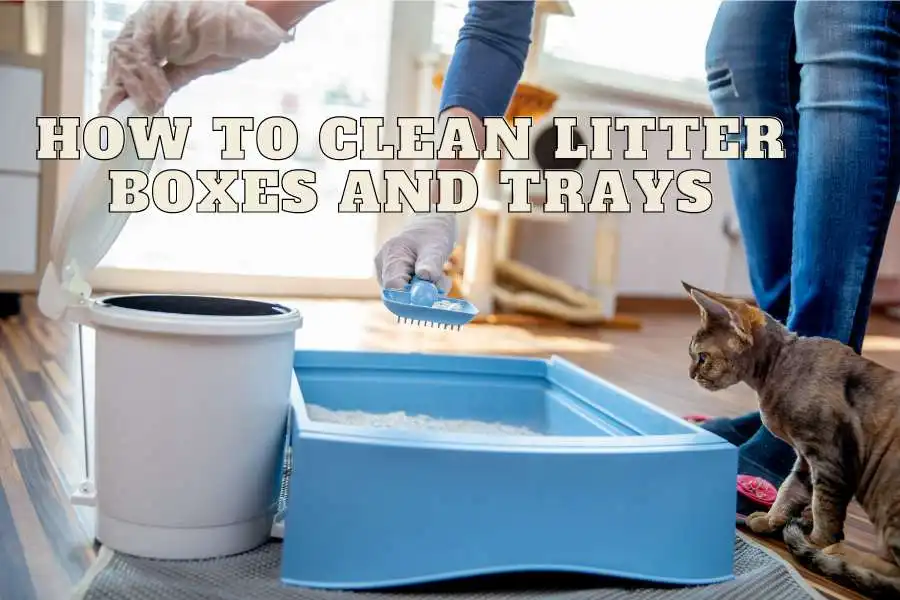Cats are known for their meticulous grooming habits, but when it comes to their litter boxes, they need a little help. This means that part of cat ownership is knowing how to clean litter boxes and maintaining them that way.
Certainly, cleaning the litter box is not a fun chore, but it’s essential for keeping a healthy and odor-free home. It also helps stop the spread of coccidial parasites like toxoplasmosis, which can be transmitted via cat poop.
Depending on the number of cats in your home, you should clean the litter box at least once a week. Importantly, ensure you scoop at least once every day to save yourself from the burdens associated with litter box aversion. Let’s delve into keeping your home smelling fresh even when you have one or two cat litter boxes in active use.
Procedure For Cleaning Your Cat’s Litter Box
This comprehensive guide will cover everything you need to know about cleaning litter boxes, from basic maintenance to deep cleaning techniques. Generally, here is how to clean litter boxes:
What To Use To Clean Litter Box

When cleaning the litter box, it’s important to use the right materials to ensure it’s clean and bacteria-free. You need:
- Protective gloves and a dust mask are especially important if you are pregnant, have low immunity, or your cat is largely an outdoor cat that can feed on all sorts of foods out there)
- Scoop: You are better off with an aluminum scoop, which does not rust or get scratched easily. Also, look for a scoop with an ergonomic handle that lowers the strain on the wrist when scooping. You can consider DuraScoop)
- Trash or garbage bags (preferably double-bagged)
- A brush or dedicated litter box sponge
- Mild, unscented dish soap
- Specialized litter box cleaner (if you opt for store-bought cleaning products)
- Vinegar, baking soda, hydrogen peroxide, or lemon juice (for DIY methods)
- Warm water
Under special circumstances, particularly when living in an apartment setting, a litter genie can be an effective tool due to its odor control ability and other benefits.
On the other hand, if you are not always motivated enough to clean the litter box, you can buy an automatic or self-cleaning litter box like the CatGenie Self Washing Self-Flushing Cat Box, which will reduce the challenge of daily maintenance of the litter box.
Specialized Commercial Litter Box Cleaners
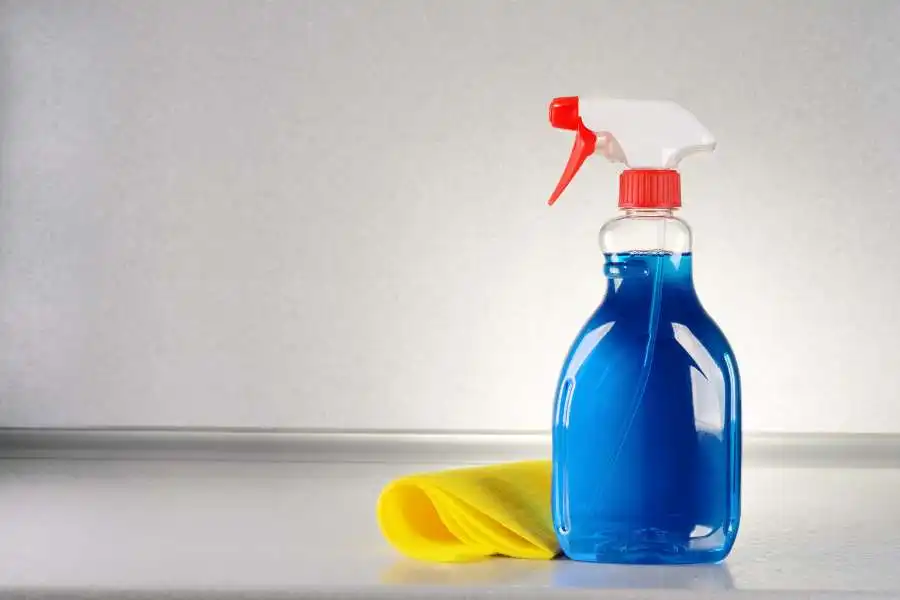
Luckily, you can buy some specially formulated litter box cleaners to clean and deodorize your cat’s litter box now and then. Commercial litter box cleaners are popular for removing stubborn stains and unpleasant poop odors and decontaminating the litter box. Some of the commercial products you can use when cleaning your cat’s litter box include:
#1. Nature’s Miracle Cat Litter Box Cleaner
This cleaning product contains bio-enzymes to help disintegrate organic stains and remove unpleasant odors from the litter box. It is safe around your cat and effectively cleans the litter box and accessories like the scoop, which many cat owners forget to wash.
#2. Simple Solution Cat Litter Box Deodorizer
This cleaning product is also specially formulated to remove tough stains and cat poop odors from your cat’s litter box. It can be safely used on numerous types of litter boxes.
#3. Arm & Hammer Litter Box Cleaner
It contains natural cleaning products such as baking soda and can effectively remove unpleasant odors from your cat’s litter box and give it a fresh smell. It is safe to use around your cat and can be used on numerous types of litter boxes.
#4. Fresh Step Litter Box Cleaner
It contains natural enzymes and plant extracts. It is also tough on stains and odors in the litter box.
DIY Litter Box Cleaner

If you want homemade solutions to clean the litter box, try the below options. However, you must be prepared to repeat some of these steps until the litter box is satisfactorily clean.
#1. Hydrogen Peroxide To Clean Litter Box
Hydrogen peroxide is a natural disinfectant that can be used to clean litter boxes; it kills the germs and zoonotic parasites in the litter box. Here’s how:
- Remove all the old litter and debris from the litter box.
- Mix hydrogen peroxide with water in a spray bottle. Use a 50/50 solution of hydrogen peroxide and water.
- Spray the solution onto the litter box, covering all surfaces.
- Let the solution sit for about 10 minutes.
- Rinse the litter box with water and let it dry completely, or dry it using a clean towel suitable for this work before adding fresh litter.
Note:
- Do not mix hydrogen peroxide with vinegar or other cleaning products, as it can produce harmful fumes.
- Note that hydrogen peroxide can bleach some surfaces.
- Therefore, test the solution in an inconspicuous place in the litter box before applying it freely on the litter box.
#2. How To Clean Litter Box With Vinegar
Vinegar is another natural cleaner that can be used to clean litter boxes. Here’s how:
- Remove all the old litter and debris from the litter box.
- Mix vinegar with water in a spray bottle. Use a 50/50 solution of vinegar and water.
- Spray the solution onto the litter box, covering all surfaces.
- Let the solution sit for about 10 minutes to disintegrate the stubborn stains.
- Rinse the litter box with water and let it dry completely, or dry it using a clean towel before adding fresh litter.
Note: Do not mix vinegar with bleach, other cleaning products, or ammonia (in cat urine), as it can produce harmful fumes such as chlorine gas.
#4. How To Clean Litter Box With Vinegar And Baking Soda
Cleaning the cat’s litter box with a solution of baking soda and vinegar removes stains and bad odors from the litter box. Here is how you can do it:
- Start by removing any litter left in the box and disposing of it appropriately.
- Apply a liberal amount of baking soda to the lower side of the litter box.
- Next, pour white vinegar on the layer of baking soda to start the fizzing reaction.
- Let the mixture of vinegar and baking soda sit in the litter for 10 minutes to disintegrate the stains and odor.
- Use a dedicated litter box sponge or brush to scrub the stubborn stains.
- Rinse the litter box with cold water to wash off any remaining vinegar and baking soda
- Allow the litter box to dry before you add fresh litter.
#5. Lemon Juice And Water
- Start by removing any litter left in the box and disposing of it appropriately.
- Put ¼ cup of lemon juice in a bowl, add 1 cup of water, and mix the solution properly.
- Apply this cleaning solution to the litter box and allow it to sit for five minutes.
- Use a sponge or brush to scrub and remove the stubborn stains from the litter box.
- Rinse it with water to wash off the lemon juice cleaning solution.
- Allow the litter box to dry, or dry it before putting in the new litter.
Learn More How To Clean Cat Litter Off Hardwood Flooring
How To Clean A Litter Box: Performing Basic Daily Cleaning And Maintenance
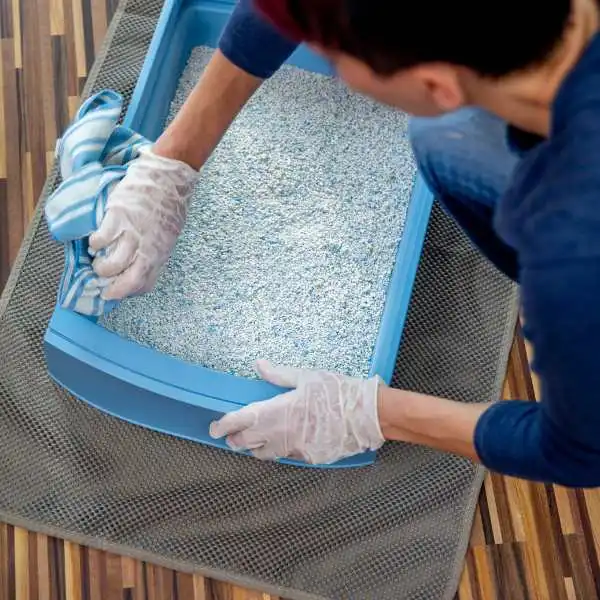
To perform daily cleaning and maintenance of your cat litter box, you should undertake the following tasks regularly:
- Ensure you scoop the litter box to remove clumps and waste and dispose of it appropriately.
- Use a litter scoop to distribute the litter level evenly in the box.
- Replenish with fresh litter and maintain the required depth of litter, which is between two and three inches for adults and about half an inch for kittens.
- Use a damp cloth or paper towel to wipe the bottom and sides of the litter box to remove litter residue and other debris. For a better cleaning experience, consider using Nature’s Miracle scrubbing wipes for litter boxes.
- If you use a litter box liner, ensure you get rid of the dirty one and replace it with a new one.
So, how often to clean poop from the litter box? If you have one cat, you should try to scoop out the poop at least once a day. In some circumstances, you may need to scoop twice daily and do other cleaning tasks more than once, particularly when you have more than one cat.
Learn Why Cat Urine Smells So Bad
How To Deep-Clean A Litter Box
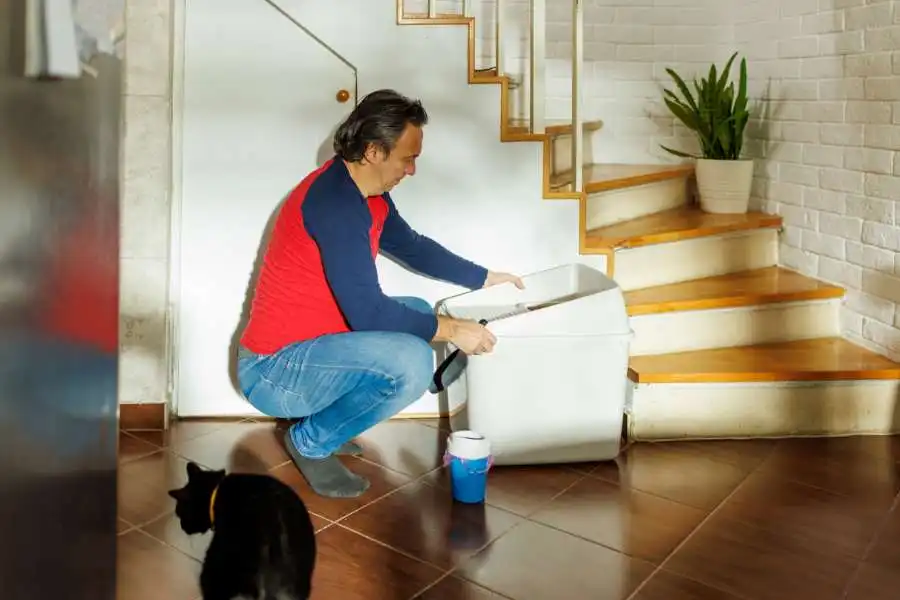
Deep-washing the litter box is essential to maintaining a clean and healthy home for your cat. It can also help eliminate bacteria and other parasites that are harmful to your cat’s health.
To deep-clean a litter robot, start by disassembling the device. The main goal is to access the litter tray for a deep clean. Disassembly will also make it easier to clean the house.
However, if you cannot disassemble the litter box, you’ll have to clean it while it’s intact. You’ll have to be creative in accessing the nooks and crannies.
Get all the tools and cleaning products you need. Ordinarily, you will require:
- A plastic bag (preferably double-bagged),
- Protective gloves,
- A dust mask,
- A scoop,
- A suitable cleaning agent and a sponge or brush dedicated to this work.
In addition, you might require a deodorizer (DIY or commercial) for both the litter box and the litter.
To wash the litter box:
Step #1: Please wear your protective gloves and begin by scooping the solid bits of waste and urine clumps from the litter and discarding them appropriately.
Then, empty the contents of the litter box into a trash or garbage bag. Avoid flushing the litter down the bathroom drains as much as possible; the drainage systems may not be designed to handle such loads.
Step #2: Mix warm water, mild, unscented dish soap, or your preferred litter box cleaner. The dishwashing soap, like Dawn, contains active surface-active agents that disintegrate and loosen litter grime and odors on the litter box.
Step #3: Soak the litter box in warm water for about 5 minutes and add a squirt of dishwashing soap to loosen the dirt on the litter box.
The goal is to remove any poop stains or litter debris that has dried on the surface of the litter box.
Then, wash and scrub the sides and bottom of the litter box using a dedicated scrub brush or sponge dedicated to the litter box. The goal of scrubbing and cleaning out your cat’s litter box is to remove the buildup of odor-causing old litter debris, stains, and dirt.
Over time, litter particles, despite their quality, disintegrate inside the litter box. The larger litter particles break off to form smaller bits that are difficult to scoop or remove and usually cling inside and on the sides of the litter box.
Step #4: Once you have removed all the stains, rinse the litter box with hot water to remove the cleaning solution from the litter box. Thereafter, allow it to air dry, or use a towel to dry it completely before deodorizing.
Step #5: Apply a specialized commercial litter box cleaner like Nature’s Miracle Cat Litter Box Cleaner, which contains bio-enzymes to break down any remaining cat stains or odors. Alternatively, you can apply a litter box deodorizer such as Simple Solution Litter Box Deodorizer Spray to give the box a fresh and pleasant smell.
Alternatively, you can also apply a solution of one part water and one part white vinegar to deodorize and disinfect the litter box.
Step #6: Rinse and dry the litter box again before adding fresh litter to the bottom of the box to a depth of between 2 and 3 inches. If your cat is particularly long-clawed, consider a depth of between 3 and 4 inches, and about half an inch for kittens.
It’s essential to avoid using harsh chemicals or cleaners when washing the litter box, as these can be harmful to your cat.
Also, though optional, consider regularly adding cat litter deodorizers such as Scent Away Cat Litter Deodorizer to keep the litter fresh and extend its life.
You Might Want To Know What Cat Pee Smells Like
How To Disinfect A Litter Box Or Tray

Disinfecting the litter box helps eliminate dangerous bacteria and pathogens, which is important for maintaining a healthy and odor-free home. To disinfect the box, follow the steps below:
Step #1: Remove the remaining litter and dispose of it in a plastic bag.
Step #2: Wash the litter box thoroughly with warm water and mild, unscented dish soap, or apply your preferred litter box cleaner.
Step #3: Use a dedicated litter box sponge or brush to remove the stubborn stains inside and on the sides of the litter box.
Step #4: Rinse the litter box with warm water to remove soap or cleaner residue.
Step #5: Next, use a disinfectant such as vinegar or hydrogen peroxide to kill bacteria or germs lurking in the box. Allow the vinegar or hydrogen peroxide to sit for ten minutes, then rinse the box with warm water.
Step #6: You can also add baking soda to the litter box to help absorb any odors and keep the box smelling fresh. Then, rinse the litter box with warm water and allow it to dry, or dry it with a clean towel, before adding fresh litter to the required depth.
How Often To Clean Poop From Litter Box

One of the most important things to remember when it comes to litter box cleaning is how often to clean the poop and debris from the litter box. Ideally, it would help if you scooped the litter box once or twice a day.
Frequent poop scooping will prevent the buildup of feces and reduce the odor in your home. However, you may need to scoop the box more frequently if you have multiple cats.
In addition to scooping, it’s essential to completely replace the litter every two to three weeks. This will ensure that your cat has a clean space to do their business and reduce the chances of bacteria growth.
If you have an automatic litter box, you should still manually scoop the poop at least once daily to get any clumped litter the automatic function might have missed and ensure that the box functions correctly.
How Much Litter To Put In Litter Box
The amount of litter you need to put in the litter box depends on the size of the box and the number of cats you have. A good rule of thumb is to have a litter depth of 2–3 inches for adults and about half an inch for kittens to make it easy for them to climb in and out of the litter box.
If the cat has longer nails, you can add to a depth of between 3 and 4 inches. On the other hand, if you have an older cat, you may need to increase the litter depth to make it easier for them to dig and cover their waste.
It’s also important to fill the litter box sparingly, as this can cause the litter to spill over and make a mess.
Litter Box Cleaning Special Situations
How To Clean Litter Box In Apartment
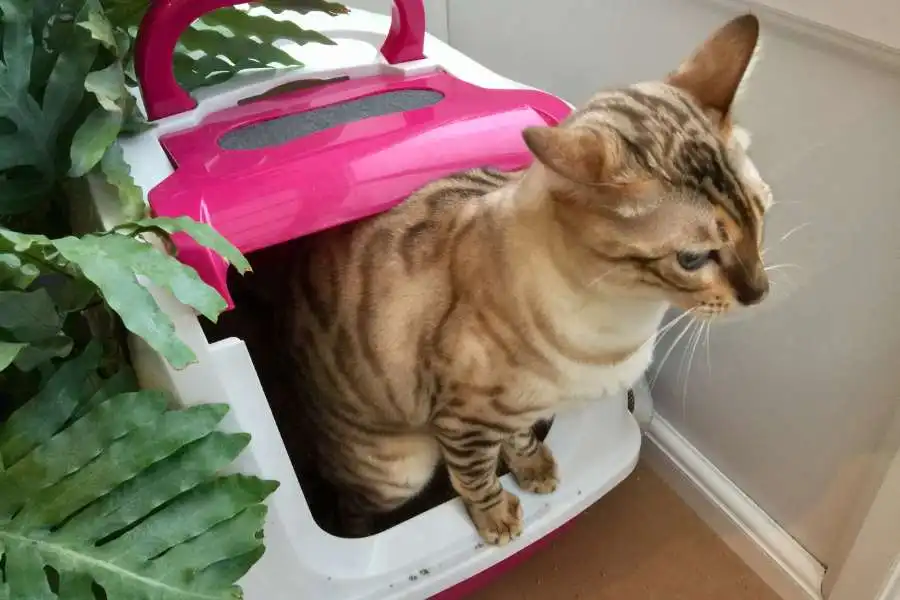
Living in an apartment means you may lack access to a private garden, yard, or outdoor hose that may be mainly useful for cleaning after pets. That’s why you might need to buy a hose attachment to help you clean the litter box inside the house, for example, in the bathroom or bathtub.
Additionally, apartment living comes with limited space and shared building areas. You must dispose of the cat waste and litter properly, taking care to avoid spillages that may inconvenience your neighbors.
Some of the tips to help you clean your cat’s litter box in the apartment include:
Tip #1: Look for a designated area from where you will be cleaning your litter box: Ideally, the area should be well-ventilated and away from where family members and guests spend most of their time.
Ordinarily, you can use the laundry area, spare bathroom, or balcony for this work. If you wash the litter box in the bathroom or bathtub, ensure you clean the entire bathroom area with bleach or other effective toilet cleaning products and disinfectants.
In the bathroom, use a handheld shower head to rinse or wash off the litter box while ensuring you do not throw the cat litter in the drains.
You might need to invest in a TubShroom that helps to trap cat litter and fur and prevents them from getting inside the drains.
Consider using Drano Max Gel Drain Clog Remover to restore normal flow if the drain gets clogged. After you are done, wash the bathroom or bathtub with appropriate disinfectants.

Tip #2: Opt for a litter box with a lid, provided your cat is comfortable using it: Such a litter box has greater efficacy in containing odor spread around your home. The litter box should be large enough for your cat but compact enough to conveniently fit the limited apartment space.
Note that a litter box with a lid may be more challenging to clean compared to an uncovered litter box, and some cats may prefer uncovered litter boxes.
Tip#3: Put a litter mat beneath the litter box: Place a litter mat below the litter box to help trap any litter your cat may track out of the box.
Tip #4: Clean the litter box regularly using a specialized litter box cleaner: Washing the litter box thoroughly using a cleaning product specially formulated for this work can help manage litter odor and deodorize the litter box.
Tip #5: Invest in a litter genie: The little genie is a small container with strong odor-blocking abilities. You can use it to dispose of cat litter instead of using a trash bag. Therefore, consider buying a litter genie like the Litter Genie Plus Pail Silver_DX, which can hold 14 days of dirty litter for one cat and is ideal for odor control in an apartment lifestyle.
Tip #6: Dispose of cat waste properly: Ensure you get rid of cat waste and litter appropriately. In addition, clean up any litter that may have been kicked out or spilled outside the litter box to keep the air in and around your home fresh.
Learn How To Clean Cat Litter Off Concrete
Litter Box Hacks for Multiple Cats
When you have multiple cats, litter box cleaning becomes an even bigger chore. Here are some hacks to make it easier:
Hack #1: Use multiple litter boxes: Experts recommend that you provide each cat with its litter box and one extra litter box. I.e., n+1, where n is the number of cats in your household.
Hack #2: Get a self-cleaning litter box: A self-cleaning litter box uses a suite of sensors to detect when a cat has used it and automatically clean the litter box. However, ensure the cat is not usually frightened by the noise that may come from automatic litter boxes, which are often motor-powered.
You can buy the CatGenie Self Washing Self Flushing Cat Box.
Hack #3: Use larger litter boxes: Bigger litter boxes can accommodate multiple cats and reduce the frequency of cleaning.
Hack #4: Place litter boxes in different areas: Cats may have a preference when it comes to where they do their business, so having litter boxes in multiple areas of the house can reduce overcrowding and keep the litter boxes cleaner.
Hack #5: Use a litter mat: A litter mat placed in front of the litter box can catch any stray litter and prevent it from spreading throughout the house.
Hack #6: Use high-quality litter: High-quality litter can reduce odors and make it easier to clean the litter box. In the same light, use the type of litter your cat prefers.
Hack #7: Scoop the Litter Box Frequently: Scooping the litter box on a daily basis is the best way to manage odors. It would be best if you scooped once or twice daily to keep the litter box appealing to the cat and control odor.
Hack #8: Consider deep cleaning the litter boxes regularly: In the long term, deep cleaning eliminates odors from the litter box and harmful bacteria and pathogens that could be lurking on the boxes. You can do this once every week.
Hack #9: Use A Photocatalyst Deodorization System To Eliminate Cat Litter Box Odor: A photocatalyst deodorizer is a filter-free air-purifier and deodorizer that works to eliminate the urine and ammonia odor that a cat litter box gives off. The device is installed above the litter box, allowing it to suck the urine-odor-infested air to purify and release fresh air.
Alternatively, you can invest in a powerful air purifier like the HARMONY 1500 Air Purifier to eliminate any traces of urine odor, particularly if you have a sensitive nose.
Preventing Problems With Litter Boxes
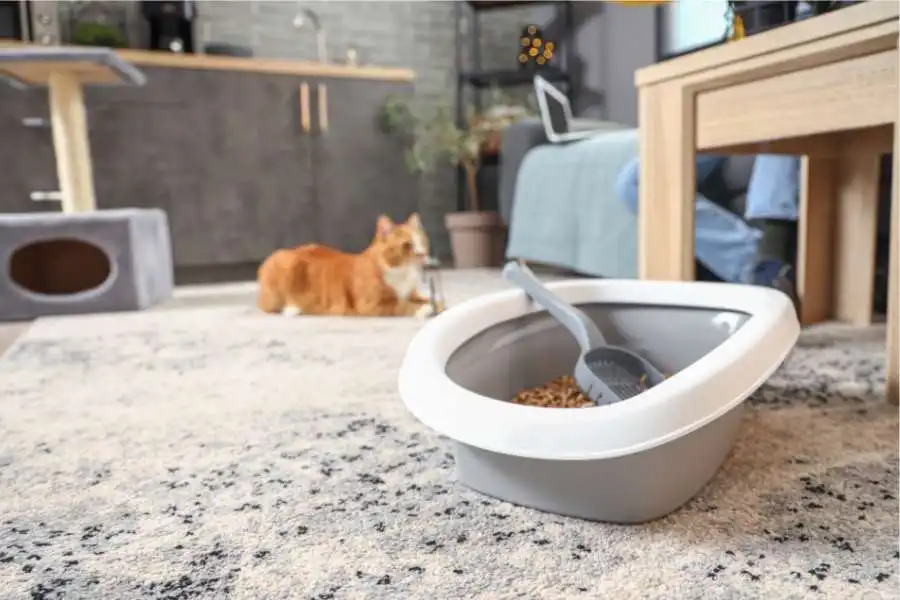
Taking a proactive approach to dealing with litter boxes is always the safest and most guaranteed way of preventing odor problems and keeping your cat safe. Some of the tips to help you avoid common problems with litter boxes include:
Litter Box Problems Prevention Tip #1: Provide the right litter to your cats: It is vital that your cat likes the litter you provide for it. That way, it is less incentivized to poop or pee outside the litter box. For that reason, consider the texture and scent that your cat prefers.
For example, some cats hate the smell of pine or citrus. Although pine litter may have stronger odor control qualities, it would be a bad idea to provide your cat with litter with such odor if it hates it.
Also, does your cat prefer clumping or non-clumping litter? Clumping litter is less likely to stick on the scoop or track outside the litter box. You may have to try different litters before you find your cat’s favorite.
Litter Box Problems Prevention Tip #2: Scoop and clean the litter box regularly: Cats like hygienic conditions and will likely avoid using a dirty litter box. Therefore, scoop at least once every day and deep clean the litter box once a week. You may have to scoop twice daily if you have multiple cats in your home.
If you clean the litter box often, you might see your cat (even a largely outdoor cat) develop tendencies to use the litter box immediately after you have finished scooping, cleaning, or deodorizing it – probably a sign that, just like humans, cats like to use pristine bathrooms.

Litter Box Problems Prevention Tip #3: Provide a sufficient number of litter boxes: If you have multiple cats, it helps to note that cats can be extremely territorial animals and, as such, might fight over limited resources like food and bathroom space. For if you have an ‘n’ number of cats, the rule of thumb is that you need n+1 litter boxes.
Litter Box Problems Prevention Tip #4: Place the litter boxes in private locations: The cat will appreciate using the litter box more in a private and serene area. The ideal location for a litter box should avoid loud noise, heavy traffic, and the cat’s dining area.
Other than the tips provided above, ensure your cat is in a good state of health, both physically and mentally. Sicknesses such as UTI or mental anxiety may lead the cat litter box aversion.
Learn How To Clean Cat Litter Off Carpets
Conclusion: How To Clean Litter Boxes
Cleaning a litter box may not be the most enjoyable task, but it is necessary for the health and happiness of your cat. Following these tips and tricks can make litter box cleaning easier and more efficient.
Remember to clean the litter box at least once daily, use the right amount, and choose high-quality litter to reduce odors. Additionally, consider investing in a self-cleaning litter box or litter box hacks for multiple cats to make the task easier.
With these cleaning methods, you can ensure that your cat has a clean and comfortable space to do their business while keeping your home smelling fresh and clean.
FAQs
Q. How often should you clean a litter box?
A. Ideally, litter boxes should be scooped at least once a day and thoroughly cleaned and disinfected every two to three weeks.
Q. Can I use bleach to clean a litter box?
A. It’s not recommended to use bleach as it can be harmful to cats. Instead, use pet-safe disinfectants or natural solutions like vinegar and baking soda.
Q. How much litter should you put in a litter box?
A. It’s recommended to fill the litter box with about 2-3 inches of litter. Too much litter can make it difficult to scoop and too little can lead to inadequate odor control.
Q. Can you clean a litter box with hydrogen peroxide?
A. Yes, you can use a mixture of hydrogen peroxide and water (1:1 ratio) to disinfect a litter box.
Q. How do you clean a litter box in an apartment?
A. The same cleaning process applies whether you live in a house or an apartment. Just be sure to dispose of the litter properly according to your building’s guidelines.
Q. How can you make cleaning the litter box easier?
A. Investing in a high-quality litter box, using a litter mat to trap excess litter, and training your cat to use the litter box properly can make cleaning easier.
Shop This Article
Nature’s Miracle® Litter Box Wipes or the
Arm & Hammer Cat Litter Deodorizer
Purina® Tidy Cats® With Glade Clumping Multi-Cat Clay Cat Litter – Clean Blossom Scent, Lightweight or the
Purina® Tidy Cats® Instant Action Clumping Multi-Cat Clay Cat Litter – Low Dust

